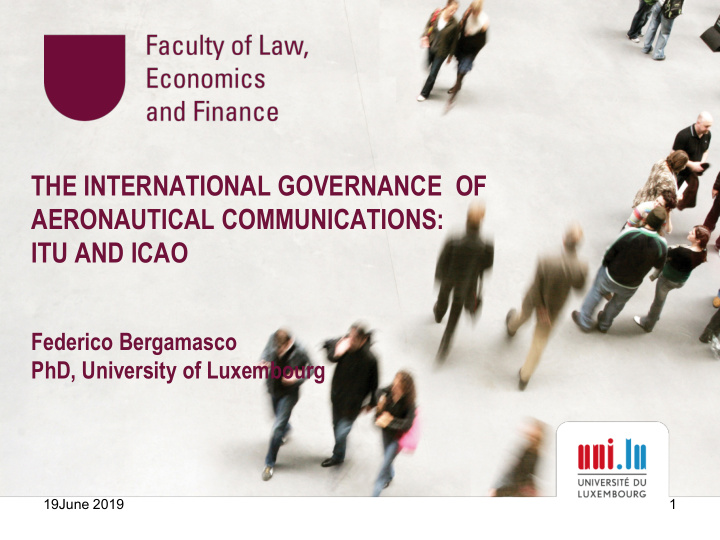



THE INTERNATIONAL GOVERNANCE OF AERONAUTICAL COMMUNICATIONS: ITU AND ICAO Federico Bergamasco PhD, University of Luxembourg 19June 2019 1
THE INSTITUTIONAL FRAMEWORK • Two main IGOs responsible for global governance of aeronautical communications: International Telecommunication Union (ITU) International Civil Aviation Organization (ICAO) • Similarities: UN Specialized Agencies technological fields in dynamic evolution technical uniformity universal membership • Different core mandate: ITU: efficient use of radio spectrum and avoidance of harmful interference ICAO: development of air navigation facilities and safety of international air navigation 19 June 2019 2
THE INSTITUTIONAL COOPERATION • ITU and ICAO overlap of competence in technical regulation of aeronautical communications: need for coordination! • Coordination mechanism: ICAO has “observer in advisory capacity” status in all ITU-R meetings, including WRC reciprocal participation of technical experts in study groups and conference preparatory meetings • ICAO concern: limited powers of its observer status reduction of aeronautical frequency allocations may threat aviation safety • ICAO Resolution A38-6: better coordination between ICAO and its Member States 19 June 2019 3
THE REGULATORY COMPETENCE • Main regulatory instruments: ITU Radio Regulations – treaty status, binding value, reviewed by WRC every 3-4 years – ensure radio compatibility between different services ICAO SARPs (Annex 10) – quasi-legislative acts, proposed by ANC and adopted by ICAO Council, much longer standardization cycles (up to 25 years) – establish safety and performance standards • Relation of ”uneven interdependence”: SARPs are to be developed within framework of RR RR revisions at WRC have potential great impact on SARPs • ICAO concern: limit of ITU-ICAO cooperation mechanism may lead to frictions between the two instruments 19 June 2019 4
THE REGISTRATION OF FREQUENCY ASSIGNMENTS • General frequency assignments: registered in ITU MIFR maintained by ITU RB right to international protection against HI from other services radio spectrum planning • Frequency assignments in exclusive aeronautical bands: ICAO registration system maintained by ICAO Regional Offices aeronautical exclusive bands (excepted HF, NDB and SATCOM) • Scarce coordination between two registration systems due to different notification competence at national level (NRAs and CAAs) • Unclear status of ICAO registered assignments 19 June 2019 5
THE RESOLUTION OF HARMFUL INTERFERENCE • Increasing radio interference episodes suffered by civil aviation: including voluntary jamming (es. South Korea 2011-12), privacy devices (es. Nantes airport 2017), military operations (es. Nicosia FIR 2018) mainly target GNSS • Resolution: ITU competence Special treatment of safety services (RR Art. 1.169, 4.10…) Resolution procedure (RR Art. 13.2, 15, 31, Appendix 10…) No enforcement powers (national administrations) • ITU-ICAO Memorandum of Cooperation: Non-binding, inter-agency exchange of information and expertise Questionable efficacy! 19 June 2019 6
CONCLUSION • Coordination between ITU and ICAO in present conditions: Overall satisfactory! No particular points of friction in WRC-19 Agenda • However, trends for the future: Spectrum congestion and air traffic growth ICAO and ITU systems under strain Likely, also their cooperation mechanisms! • Need for different cooperation model? From consultation to…? Wider questions of global governance 19 June 2019 7
THANK YOU FOR YOUR ATTENTION! Credit ESA 19 June 2019
Recommend
More recommend